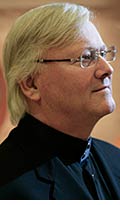Alumnus who designed world’s tallest building to receive honorary doctorate degree

Adrian Smith, designed the world’s tallest building ...

... the Burj Khalifa in Dubai.
[Adrian Smith] (http://archone.tamu.edu/college/news/newsletters/spring2010/stories/Smith_Burj.html) , designer of the world’s tallest building, the Burj Khalifa in Dubai, and a champion of sustainable design, will receive an honorary doctor of letters degree from Texas A&M at spring commencement.
Widely regarded as the world’s leading authority on super-tall buildings, Smith is an [outstanding alumnus] (http://one.arch.tamu.edu/news/2011/5/10/2011-outstanding-alumni/) of the College of Architecture and founding principal of [Adrian Smith + Gordon Gill Architecture] (http://smithgill.com/) .
His honorary degree was authorized by the Texas A&M University System Board of Regents at their Jan. 31, 2013 meeting, following recommendations from the Texas A&M Faculty Senate and university president R. Bowen Loftin.
Others receiving honorary doctorates this spring are Robert Bergman, an organic chemist at the University of California-Berkeley, and Temple Grandin, an expert in animal handling facilities design, beef cattle behavior and processing.
The Burj Khalifa, a shimmering spire rising more than half a mile, 2,716.5 feet, above Dubai in the United Arab Emirates, was among the projects Smith discussed at the 2011 [Rowlett Lecture] (http://archone.tamu.edu/college/news/newsletters/spring2011/stories/Rowlettlecture_Feb18.html) , an event showcasing the work and best practices of leading architectural firms hosted annually by Texas A&M's [CRS Center] (http://crs.arch.tamu.edu) for Leadership and Management in the Design and Construction Industry.
“The profile of the Burj has a magnetism that is lacking in almost every other super-tall building of our time,” [wrote] (http://www.newyorker.com/arts/critics/skyline/2010/02/08/100208crsk_skyline_goldberger) the New Yorker’s Paul Goldberger. “Furthermore, the tower doesn’t indulge in the showy engineering tricks that have become so common today; it doesn’t get wider as it rises, or lean to one side, or appear to be made of broken shards. There is something appealing about a building that relies on the most advanced engineering but doesn’t flaunt it.”
Smith also designed the 3,280-feet-tall [Kingdom Tower] (http://one.arch.tamu.edu/news/2011/8/2/smith-kingdom-tower/) in Jeddah, Saudi Arabia, which is destined to be the world's tallest building when completed in 2017.
In addition to designing super-tall, sustainable buildings, Smith’s firm is committed to the greening of existing structures and helping the building design industry meet its goal of “zero net energy” buildings by the year 2030.
Toward that end, AS+GG developed plans for a "green" retrofit of Chicago's [Willis Tower] (http://smithgill.com/work/willis_tower/) , popularly known as the Sears Tower, that could cut the building’s electricity usage by 80 percent.
It has also completed a master [plan] (http://smithgill.com/news/great_city_press_release/) for Chengdu Tianfu District Great City, a self-sustaining, environmentally sensitive 1.3-square-kilometer satellite city near Chengdu, China that begins construction this fall.
Great City will use 48% less energy and 58% less water than a conventional development of similar population and produce 89% less landfill waste and generate 60% less carbon dioxide.
Smith’s journey to the height of his profession began with four years of architecture study at Texas A&M from 1962-1966, before he was lured to Chicago for a summer internship, where he eventually finished his degree at the University of Illinois at Chicago and landed a job at Skidmore, Owings & Merill.
He stayed at SOM for four decades, advancing through the ranks and eventually serving as chief executive officer from 1992 – 95, before leaving in 2006 to start AS + GG.
Tags
Related Posts

2015 Rowlett lecturer championed shaping the future by design

Essay highlights professor emeritus’ social activism
Smith’s firm wins global design contest
College names six outstanding alumni

Posters, addresses earn students 2017 research week honors
Follow Us
Facebook Twitter Vimeo Youtube Flickr RSS
Recent Posts

Planning prof heads study of disaster housing aid

A message from the dean

Former student remembered as expert planner

Leading educator named new head of Architecture Dept.










_thumbnail_small.png)
